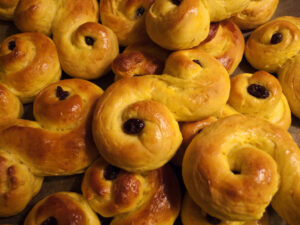
St. Lucia Day
December 13th is the day that Swedes and others all over the world honor the legend of Saint Lucia. For many, many years Lucia has brought faith, hope, and a reason to believe in good things to come. Her legend stems from Syracuse on the island of Sicily. It is thought that during a time when the rulers of the land did not look favorably upon Christianity, a woman named Lucia had devoted her life to God and the poor. She gave her entire dowry to the poor, and the man she was to marry was very upset by this. Lucia was put on trial, refused to renounce her Christian beliefs and was declared a witch. She was to be burned at the stake but when the guards tried to light the fire it would not light. Ultimately, she was stabbed.
There are many theories on how the legend of Lucia came to Sweden. It could have been brought by priests, German traders or even by the Vikings in their adventures to southern Europe. No one knows just how it evolved into the uniquely Swedish tradition it is today, and there are many versions of a Swedish Sankta Lucia story.
One popular version is a story of a terrible famine many years ago. On December 13th a well-lit ship on Lake Vannern approached the shore carrying a woman at the helm dressed in white with a glow around her head. Having heard the Italian version the starving people thought it could be Saint Lucia coming to save them from this terrible famine.

Many Swedes believe that the Swedish version of the legend has to do only with the fact that Lucia comes from the root word “Lux” which means light.
The tradition of celebrating St. Lucia in Sweden really did not start to evolve until the late 1800’s. Many families today celebrate it in their homes. The eldest daughter dresses in a long white gown with a red ribbon tied at the waist. She dons a crown of fresh greens and lit candles on her head.
Lucia can be attended by younger siblings, girls (attendants) in white robes with tinsel around their waists and heads, and boys (starboys) in white robes, cone hats, and carrying stars. Very early in the morning hours the children serve coffee and Lussekatter (Lucia buns) to all the people in the house while singing traditional Swedish Lucia songs.
Swedes also celebrate St. Lucia Day in local churches, businesses, and schools. Many towns and cities have a Lucia contest for all of the girls who have reached a certain age. Being chosen the town’s Lucia is quite an honor for any young lady.
Recipe for Lucia Buns (Lussekatter)

Reprinted from the Var Så God cookbook with permission from the American Swedish Institute
(Makes 4 dozen rolls)
| 1 pkg active dry yeast | 2 eggs |
| 1/4 c water, warm | 1/4 tsp salt |
| 3/4 c milk | 1/4 tsp powdered saffron |
| 1/2 c butter or margarine | 4 c flour |
| 1/2 c sugar | For brushing: 1 egg and 2 T water |
Dissolve yeast in warm water and set aside. Warm milk, add butter to melt. Place all above ingredients in a mixing bowl using 2 cups of the flour. Mix for 3 minutes using mixer. Add rest of flour and beat with wooden spoon. Work dough on board adding a little flour for easy handling. When smooth and shiny put in a bowl and let rise to double in bulk. Turn out on floured board and shape into Lussekatter. Let rise in cookie sheet and brush with egg and water mixture before baking. Put a raisin in each curl and bake at 450’ for 10 minutes.
Printable version of recipe: Recipe for Lucia Buns
– Gunhild Anderson
